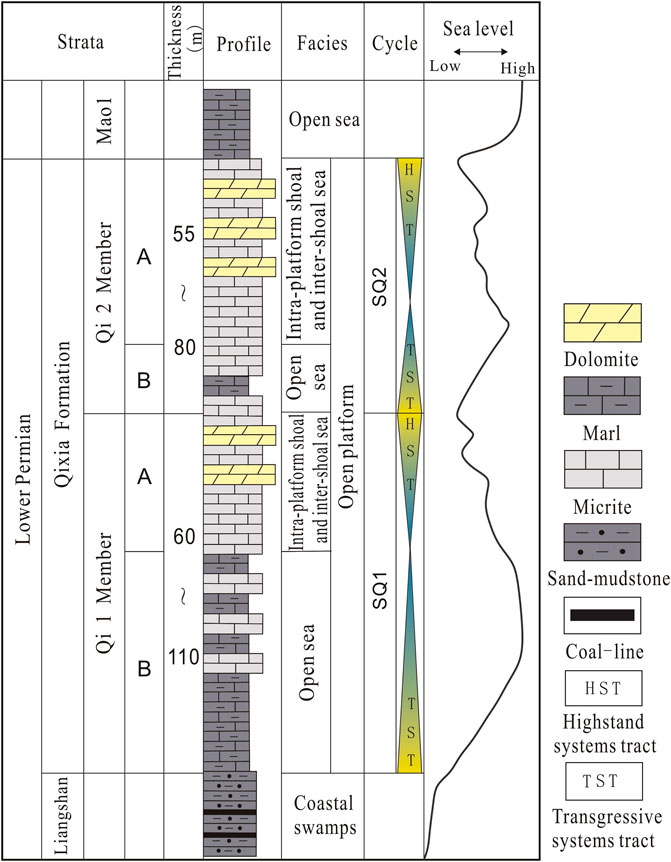Development characteristics and controlling factors of dolomite reservoirs of permian Qixi a Formation in central Sichuan Basin
- Research Institute of Petroleum Exploration and Development Northwest Branch, Lanzhou, China
In recent years, with the fine exploration of carbonate reservoirs in the Qixia Formation, central Sichuan Basin, researchers have made important oil and gas discoveries in the dolomite reservoirs. However, the characteristics, genesis and controlling factors of dolomite reservoirs in the Qixia Formation in this area are still unclear. In this paper, the petrology, pore structures, physical properties and geochemical characteristics of the dolomite reservoirs in the Permian Qixia Formation in the central Sichuan Basin have been systematically studied based on a large number of cores, thin sections, physical property and geochemical tests. Furthermore, the genesis and main controlling factors of dolomite reservoirs are clarified. The study shows that the dolomites have the characteristics of small single-layer thickness and multi-layer development, and they are usually interbeded with the limestones. The reservoir types are mainly fine crystal and fine medium crystal dolomite, and the reservoir spaces include intercrystalline pores and dissolution pores (or caves). Moreover, the reservoir physical properties are characterized by medium porosity and medium to high permeability. Quasi-syngenetic dolomitization is the main origin of dolomite in the target layer, and the dolomite was slightly modified by hydrothermal solution at the end of the Maokou Formation period. The development of dolomite reservoirs in the Qixia Formation in the study area is affected by palaeogeomorphology, sedimentation and diagenesis. The granular shoal facies developed in the high parts of the paleogeomorphology provides the material basis for the formation of dolomite reservoirs. The high frequency sequence interface controls the development of dolomite reservoirs in the highstand systems tract. In addition, the quasi-syngenetic dissolution promots the development of the early secondary pores and provids an effective channel for the migration of the diagenetic fluids in the later stage. In the direction of orthogonal horizontal deposition, the dolomites have the characteristics of thin monolayer thickness, multiple sequences and are interbedded with limestone. The dolomite shoals in the study area are distributed as clumps in the plane, which has great potential for hydrocarbon exploration.
1 Introduction
Carbonate reservoir is a kind of unconventional tight reservoir with low porosity, low permeability and strong heterogeneity. Carbonate reservoirs are developed in the Tarim Basin, Sichuan Basin, Qaidam Basin, Bohai Bay Basin and Ordos Basin in China (Hong et al., 2004; Chen et al., 2012; Jiang et al., 2018; Xie et al., 2022). Dolomite is usually deposited in the closed water environment with strong evaporation, and its physical properties are usually good (Huang et al., 2001; Chen et al., 2012). Therefore, it is a typical high-quality carbonate reservoir. A large number of studies have shown that the factors affecting the quality of dolomite reservoir include sedimentary facies, diagenesis, tectonic activity and paleogeomorphology (Xiong et al., 2017; Jiang et al., 2018).
In recent years, with the fine exploration of carbonate reservoirs in the Qixia Formation, central Sichuan Basin, researchers have made important oil and gas discoveries in the dolomite reservoirs. Recently, several wells have obtained high-yield gas flows in the Qixia Formation of the Moxi and Gaoshiti areas in the central Sichuan Basin, which shows that the Qixia Formation has great potential for oil and gas exploration and development. At present, some scholars have carried out a lot of research on the characteristics and genesis of dolomite reservoirs in the Permian Qixia Formation, Sichuan Basin (Bau and Dulski., 1996; Veizer and Azmy., 1999; Meyer et al., 2013; Geske et al., 2015). Generally, the genesis of dolomite reservoir mainly includes syngenetic dolomitization, burial dolomitization, mixed water dolomitization, structural hydrothermal dolomitization, and multi-stage superimposed dolomitization (Burke et al., 1982; Crozaz et al., 2003; Mazumdar et al., 2003; Morozov et al., 2021; Richardson et al., 2022; Gao et al., 2023). It is generally believed that the development of dolomite reservoirs in the Permian Qixia Formation in the Sichuan Basin is mainly controlled by sedimentary facies, tectonic-hydrothermal and early karst controlled by multiple sequence interfaces. However, these viewpoints can not accurately explain the phenomena of thin layer thickness and strong lateral heterogeneity of dolomite reservoirs in the Qixia Formation in central Sichuan Basin. At present, there is no systematic study on the characteristics, genesis and controlling factors of dolomite reservoirs in the Qixia Formation in the central Sichuan Basin, and it is difficult to accurately predict the distribution of dolomite reservoirs. In this paper, the petrology, pore structures, physical properties and geochemical characteristics of the dolomite reservoirs in the Permian Qixia Formation in the central Sichuan Basin have been systematically studied based on a large number of cores, thin sections, physical property and geochemical tests. This study can provide theoretical and technical supports for gas exploration and development of the Qixia Formation in this area.
2 Geological background
The Sichuan Basin is a large hydrocarbon superimposed basin in western China. It covers an area of about 18 × 104 km2 and is a rhomboid petrol-bearing basin extending in the northeast direction. The tectonic units of the Sichuan Basin include the West Sichuan Foreland Depression, the Middle Sichuan Gentle Fold Area, the North Sichuan Thrust Fold, the East Sichuan High and Steep Structural Area, the South Sichuan Low and Steep Fold Area and the Southwest Sichuan Uplift Area. The study area is located in the Middle Sichuan Gentle Fold Area of the Sichuan Basin (Figure 1).
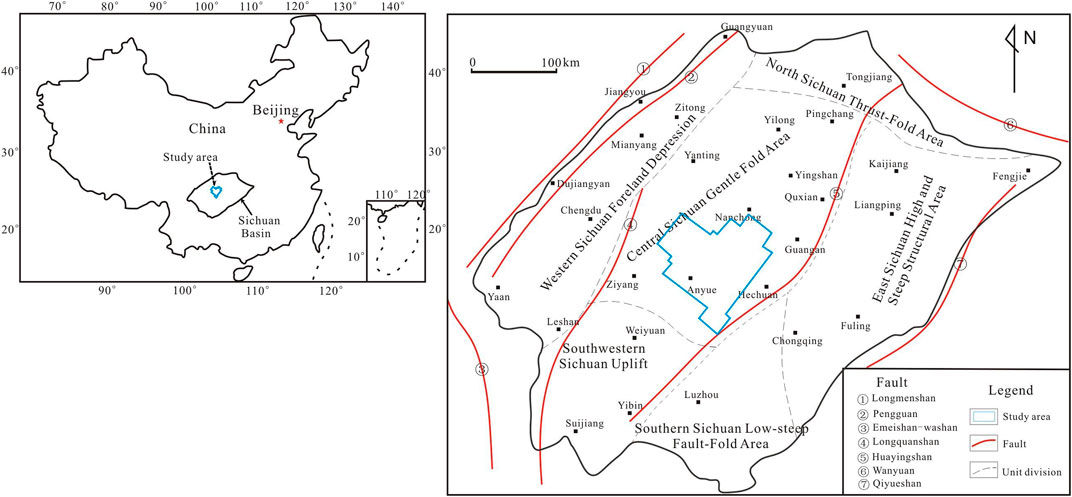
FIGURE 1. Structural location of the study area (modified according to Tan et al., 2022).
From bottom to top, the Liangshan and Qixia Formations are developed in the Lower Permian in the central Sichuan Basin, and the overlying strata is the Middle Permian Maokou Formation (Figure 2). The Liangshan Formation is in unconformity contact with the underlying strata, while it is in conformity contact with the Qixia Formation. The Liangshan Formation is a set of shore-marsh facies sand and mudstone deposits interbeded with coal lines. The bottom of the Maokou Formation is a set of bioclastic limestone and micritic bioclastic limestone deposits rich in argillaceous components, which are in parallel unconformity contact with the Qixia Formation. The Qixia Formation is divided into the Qi one and Qi two sub-members. Dark grey-black gray argillaceous and bioclastic micritic limestones are developed in the Qi one sub-member. While gray bioclastic limestone, dolomite and a small amount of black siliceous mass are usually found in the Qi two sub-member. The thickness of the Qixia Formation is 100–150 m, and it belongs to the facies of open platform, grain shoal and open sea (or intershoal sea) of carbonate rocks. According to statistics, the average thickness of the single shoal body in the granular shoal is mostly between .5 m and 1.2 m, and the thickest can reach 2.1 m. The granular shoal is mainly developed in the top of the Qi one sub-member and the middle and upper parts of the Qi two sub-member.
3 Materials and methods
The experimental samples of this study were collected from the Wells MX42 and MX108 in the central Sichuan Basin. The carbon and oxygen isotopes were determined using an isotope ratio mass spectrometer, Delta V Advantage. The standard 100% phosphate method was used to perform carbon and oxygen isotope tests. The test accuracy meets: δ13C<.01‰, δ18O<.02‰. The strontium isotope was determined via a thermoionization isotope ratio mass spectrometer TRITON PLUS. The ambient temperature was 22 °C, the relative humidity was 66%, and the error range was between .000014 and .000084. The cerium and europium isotopes were determined using a solid isotope mass spectrometer ThermoFisher TRITON TI. The heating temperature was 1,000°C, the vacuum degree of ion source was 1.1 × 10−7 mbar, and the mass stability was less than .00001. Exponential laws were used for isotopic ratio corrections.
4 Results
4.1 Petrological characteristics
The lithology of the Permian Qixia Formation in the central Sichuan Basin is mainly bioclastic limestones and argillaceous bioclastic limestones, followed by dolomites with good reservoir properties. According to the crystal size, the dolomites in the Qixia Formation are mainly fine crystal and fine-medium crystal dolomites (Figures 3A,B), followed by coarse-crystal dolomites (Figure 3C), mud-silt crystal dolomites (Figure 3E) and saddle-shaped dolomites (Figure 3F) are rare.
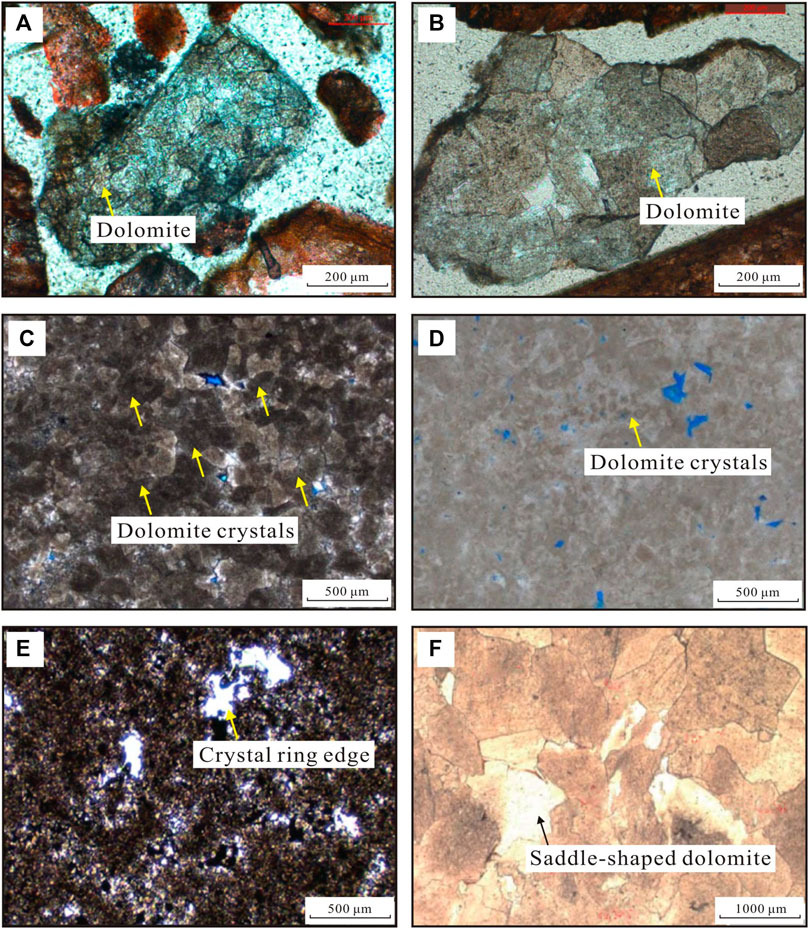
FIGURE 3. Microcosmic characteristics of dolomites of Permian Qixia Formation in central Sichuan Basin. (A) Moxi well 131X1, 4,291 m, mesocrystalline dolomite; (B) Gaoshi 128 well, 4,288 m, fine—medium crystalline dolomite; (C) Moxi 42 well, 4651.43 m, medium coarse crystal dolomite with blurred crystal edge; (D) Moxi 42 well, 4651.43 m, with obvious biodebris; (E) Heshen two well, mud-silty sand-clastic dolomite, 4357.5 m, with sparry ring edges on grain edges; (F) Gaoshi 16 well, saddle-shaped dolomite, 4556.4 m, coarse crystal, curved crystal surface and dissolution pores.
Grain dolomites are mainly medium—thin layer light gray—gray dolomites. Under the microscope, the dolomite crystals appear as hedral and semi-hedral crystals. The heteromorphic crystals mostly have non-flat crystal planes, and the crystal morphology and contour are not clear (Figure 3C). In addition, the morphology of some crystals can only be recognized under orthogonal light, and most crystals have wave-like extinction characteristics. Residual biodebris can occasionally be found. Distinct bioclastic structures can be observed when a fraction of hedral crystalline dolomites are restored (Figure 3D), including foraminifera, terraines, and corals. According to the observation results, the semi-hedral and hedral crystals have flat crystal planes, which are mostly found in the medium coarse crystal dolomites. The grain core is dirty and the color of the ring edge is usually bright. If the crystal shape is good, the bright edge fog center structure is obvious (Briais et al., 1993; Budd, 1997; Hong et al., 2004; Ma et al., 2023).
Mud-silty dolomite can be observed only in the upper part of the Qixia Formation in Well Heshen 2. The mud-silt particles are sand-like and mostly surrounded by sparry dolomite ring edges (Figure 3E). The pores of fine crystal dolomite are usually filled or semi-filled with asphalt. In addition, it can be observed in the cores and under the microscope that the caves or soluble seams are always filled with saddle-shaped dolomites with non-flat crystal plane (Hu and Wang., 1990; Chacko and Deines., 2008). The dolomites have coarse grains and large curved crystal surfaces, and they have wavy extinction characteristics under orthogonal polarization conditions (Figure 3F).
4.2 Developmental characteristics of pores
The reservoir space of dolomite reservoirs of the Qixia Formation in the central Sichuan is mainly composed of intergranular pores, intergranular dissolution pores and caves, accounting for 60%–80%; followed by the residual intergranular pores and residual intra granular pores, accounting for 20%–40%. In addition, a few micro-fractures and dissolution expansion fractures are also developed.
Intercrystalline pores are unfilled pores between grains of dolomite, and the dolomites have flat edges. The intercrystalline pores have irregular polygonal shape, and often appear as triangular pores. This type of pores have a high development frequency with pore sizes ranging from .01 mm to .5 mm (Figure 4A). There are obvious dissolution traces on the inner edges of some pores, and the surface ratios are between 1% and 8%. Intercrystalline pores exist in all kinds of crystalline dolomites. They are mostly found in fine-mesocrystalline and mesocrystalline dolomites, and their main throat types are constricted or flaky throats.
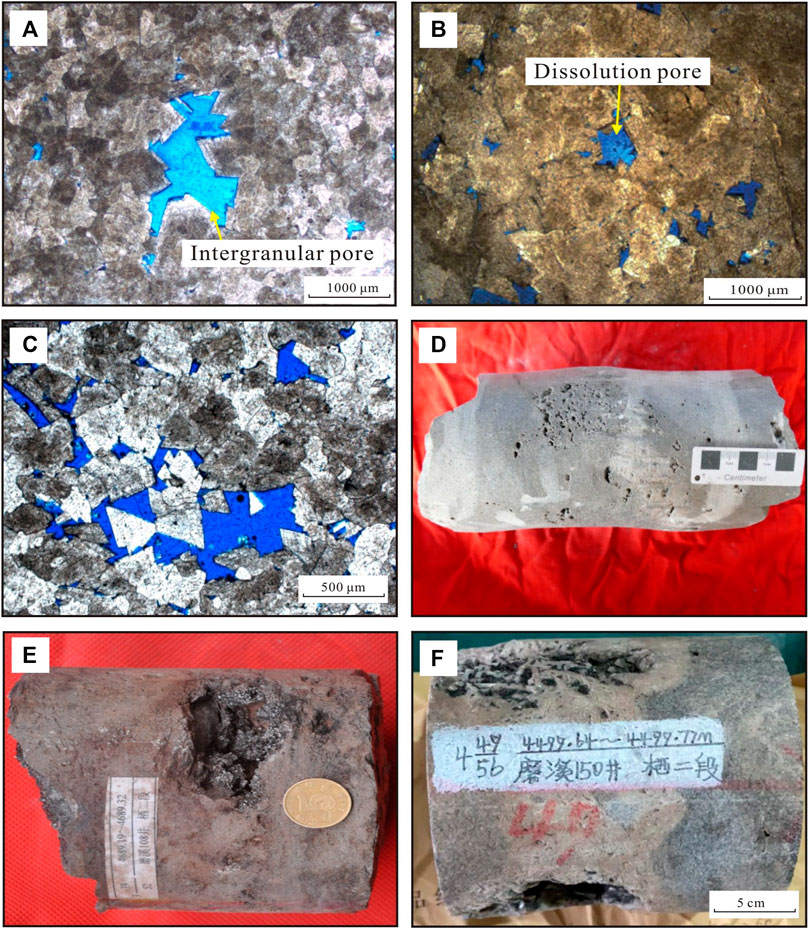
FIGURE 4. Development characteristics of pores developed in dolomite reservoirs of Permian Qixia Formation in central Sichuan Basin. (A) Moxi 42 well, 4,656 m, crystalline dolomite, intercrystalline pores; (B) Moxi 108 well, medium granular dolomite, 4671.25 m, intercrystalline dissolved pores; (C) Moxi 150 well, 4500.7 m, mesocrystalline dolomite, intercrystalline pores and intercrystalline dissolved pores; (D) Moxi 151 well, granular dolomite, 4483.70–4483.93 m, dissolution pores; (E) Moxi 108 well, granular dolomite, 4689.19–4689.32 m, dissolution pores; (F) Moxi 150 well, granular dolomite, 4499.64–4499.77 m, dissolution pores.
The intercrystalline pores can be strongly dissolved under the action of acidic fluids, and then the intercrystalline dissolved pores are formed (Figures 4B,C). The dolomite grains at the pore edges have obvious cove—shaped dissolution edges. According to the statistics, the pore size of the intercrystalline dissolved pores is in the range of .05–1.0 mm, and the surface ratio is in the range of 2%–11%. Intercrystalline dissolved pores are mainly developed in cave-filled dolomites and pinhole matrix dolomites.
Dissolution pore is the most developed pore type in the Permian Qixia Formation in the central Sichuan Basin. They appear as residual dissolution pores filled with dolomite or bitumen. The pore sizes of the dissolution pores vary greatly, with the main pore sizes ranging from .1 cm to 4 cm (Figures 4D–F). The millimeter-level spiculate dissolution pores are distributed uniformly in local layers, while the centimeter-level dissolution pores have irregular and heterogeneous distribution characteristics. The caves are mostly filled with macrocrystalline calcite, medium coarse-grained dolomite, saddle-shaped dolomite, quartz and asphalt.
4.3 Physical characteristics
According to the physical test results of samples taken from the target layer (Figure 5), the minimum porosity of the limestone samples is .04%, while the maximum porosity is 9.06%, and the average porosity is .57%. The samples with porosity less than 1% account for 88.9% of the total samples; while the samples with porosity greater than 4% account for only .6% of the total samples. The minimum permeability of the limestone samples is close to 0, while the maximum permeability is 4.75 × 10−3 μm2, and the average permeability is 1.05 × 10−3 μm2. The samples with permeability less than 1 × 10−3 μm2 accounted for 83.4% of the total samples. For the dolomite samples, the minimum porosity is .43%, the maximum porosity is 10.86%, and the average porosity is 4.12%. The samples with porosity greater than 2% accounted for 70.3% of the total samples. In addition, the minimum permeability is close to 0, the maximum is 101.6 × 10−3 μm2, and the average is 6.32 × 10−3 μm2. The samples with permeability greater than 1 × 10−3 μm2 accounted for about 62.1% of the total samples.
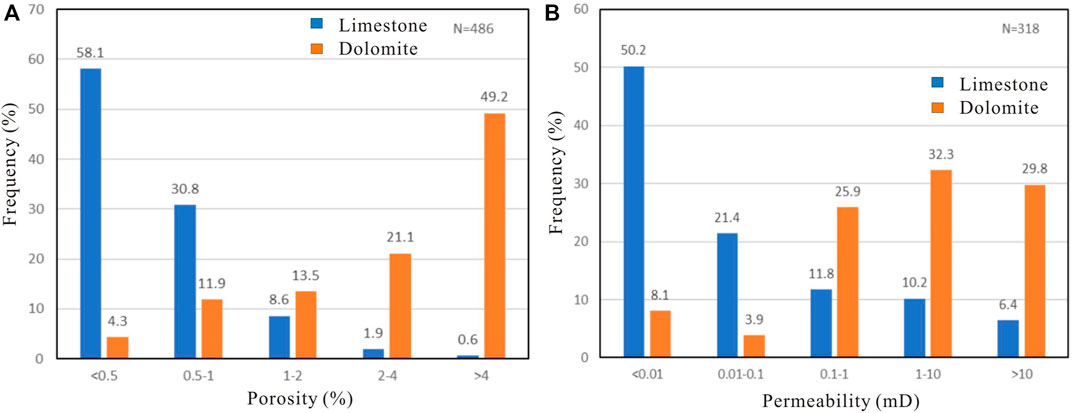
FIGURE 5. Histograms of physical property distribution of limestones and dolomites in Permian Qixia Formation in central Sichuan Basin. (A) Porosity distribution histogram; (B) Permeability distribution histogram.
The dolomite of the Qixia Formation in the study area has better reservoir performance than limestone. This is because the dolomite is formed on the basis of bioclastic limestone and other granular rocks by dolomitization. Under the action of dolomitization, the gray matter minerals are transformed into dolomite, and the strength and pressure solubility of the rock are increased. At the same time, the dissolution pores and caves are easy to form in dolomite after the dissolution in the quasi-syngenetic period.
4.4 Carbon and oxygen isotopes
The fractionation effect of carbon isotopes in carbonate rocks is little affected by temperature and pH. In the process of carbonate precipitation, carbon isotope changes only slightly, so it can objectively reflect the original carbon isotope composition of seawater. The oxygen isotopic composition of carbonate rocks is mainly controlled by fluid fractionation during deposition, open-seal degree of sedimentary environment, hydrothermal process and temperature during diagenesis. The higher the temperature, the more negative the oxygen isotopes of the precipitated minerals.
The δ13C values of the Permian Qixia Formation limestones in the central Sichuan Basin range from 2.89‰ to 5.23‰, with an average of 4.21‰; while the δ18O values range from −6.85‰ to −5.31‰, with an average of −6.22‰. In addition, the δ13C values of dolomites range from 3.68‰ to 5.25‰, with an average of 4.73‰, and the δ18O values range from −8.35‰ to −7.02‰, with an average of −6.52‰. As a whole, the δ13C values of the dolomites and limestones are located in the Early Permian seawater, while the δ18O values are roughly or slightly lower than those of the contemporaneous seawater (Figure 6). The negative oxygen isotope indicates the existence of obvious thermodynamic fractionations. Moreover, the formation of dolomites may be influenced by the hydrothermal processes, namely, hydrothermal dolomitization.
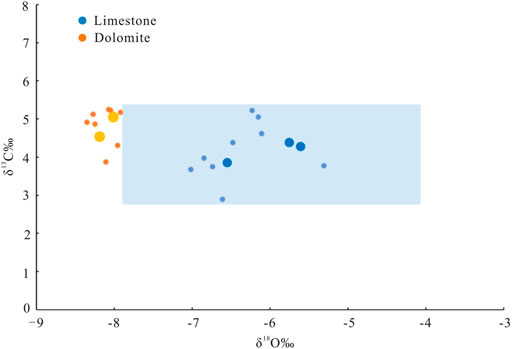
FIGURE 6. Carbon and oxygen isotope characteristics of limestones and dolomites of Permian Qixia Formation in Central Sichuan Basin (partial data from Chen et al., 2012). The blue area represents the range of carbon and oxygen isotopes in early Permian seawater; the enlarged symbol data comes from Chen et al., 2012.
4.5 Strontium isotope
In geological history, the composition of strontium isotopes in seawater is a function of time. The change of strontium isotope with time is mainly controlled by two strontium sources: ① Strontium of relatively radioactive origin is provided to seawater by weathering of ancient continental siliceous aluminaceous rocks through rivers. It has a high 87Sr/86Sr ratio (Huang et al., 2006). ② Relatively radiation-depleted strontium that is supplied by mid-ocean ridge hydrothermal systems through seafloor spreading or volcanic activities. It has a low 87Sr/86Sr value (Huang et al., 2006). The mixing time of strontium in seawater (about .001 Ma) is much less than the residual time of strontium in seawater (about 1 Ma). Therefore, the isotopic composition of marine strontium is the same all over the world at any time. Unlike carbon and oxygen isotopes, strontium isotopes do not fractionate due to temperature, pressure and microbial effects, and minerals can directly reflect the isotopic composition of fluids (Mazzullo, 2000; Li and Liu., 2013; Pajdak et al., 2017).
According to statistics, the 87Sr/86Sr values of micritic limestone of the Permian Qixia Formation in the central Sichuan range from .70661 to .70755, with an average value of .70712; the 87Sr/86Sr values of micritic bioclastic limestones in the Permian Qixia Formation range from .707,009 to .70767, with an average of .70748; the 87Sr/86Sr values of the granular dolomites range from .70765 to .71045, with an average of .70844; in addition, the 87Sr/86Sr values of the saddle-shaped dolomites range from .70765 to .70939, with an average of .70832.
By comparing the 87Sr/86Sr values of the global Permian seawater, it is found that the 87Sr/86Sr values of the micritic limestones and micritic bioclastic limestones fall within the seawater range of the same period, while that of the granular and the saddle-shaped dolomites are higher than the seawater range of the same period (Figure 7) (Huang et al., 2001; Jiang et al., 2018). Therefore, the formation of granular and saddle-shaped dolomites may be modified by strontium-rich fluids.
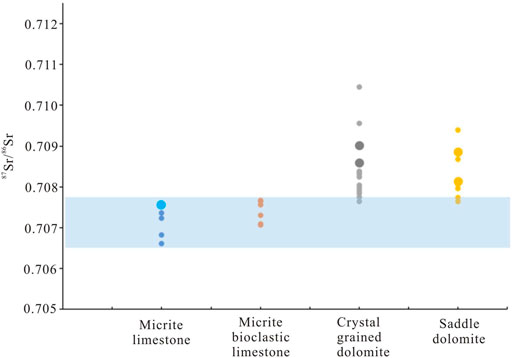
FIGURE 7. 87Sr/86Sr isotopic characteristics of different lithologies of Permian Qixia Formation in Central Sichuan Basin (partial data from Jiang et al., 2018). The blue area represents the 87Sr/86Sr range (.70662–.70774) of Permian seawater; the enlarged symbol data comes from Jiang et al., 2018.
The large scale magmatic activities in the late Early Permian in the Sichuan Basin is the eruption and intrusion of basic rocks. In turn, the hydrothermal dolomites have other sources of 87Sr-rich strontium isotopes. When the deep hydrothermal fluids passed through the underlying Cambrian Qiongzhusi Formation shale, it probably mixed with the 87Sr-rich pore fluids in clastic rocks, and migrated upward to the Permian system. Finally, recrystallization and hydrothermal precipitation resulted in 87Sr-rich in granular and saddle-shaped dolomites inside the fractures and caves.
4.6 Cerium and europium isotopes
Eu and Ce are abnormal in different diagenetic environments due to the change of valence state (Vasconcelos et al., 1995; Machel, 2004; Haas et al., 2017). Thus, they can be used to indicate different diagenetic environments. For example, Ce is sensitive to environmental redox properties in aqueous solution and precipitation process, and it often fractionates with other trivalent rare Earth elements. Ce3+ is oxidized to Ce4+ under oxidizing conditions. Ce4+ is less soluble and more thermodynamically stable than other trivalent rare Earth elements (Davies and Smith., 2006; Cheng et al., 2022). The insolubility and preferential adsorption of Ce4+ on the particle surface lead to the separation of Ce4+from other rare Earth elements, and this process leads to the negative anomaly of Ce.
The δCe values of the Permian Qixia Formation limestones in the central Sichuan Basin range from .73 to 1.01, with an average of .85; while the δEu values range from .94 to 1.3, with an average of 1.09. The δCe values of dolomites range from .73 to 1.01, with an average of .89, and the δEu values range from .97 to 1.98, with an average of 1.23. The δCe and δEu values of micritic limestone are .68 and .73, respectively. As can be seen from Figure 8, when δCe is less than 1 and δEu is greater than 1, the Ce element has a slight negative anomaly, while the Eu element has a slight positive anomaly. The δCe and δEu values of all the samples are higher than those of the micritic limestones under the seawater of the same period. It reflects that the formation environment of dolomites is oxidation and high temperature.
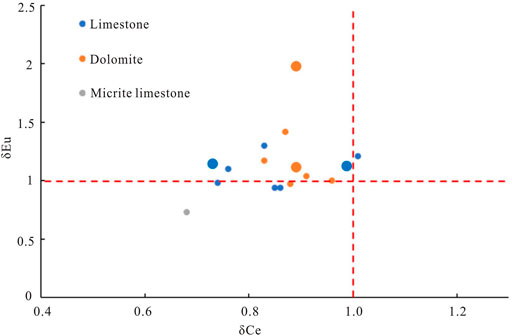
FIGURE 8. Distribution of Eu and Ce in dolomites of Permian Qixia Formation in Central Sichuan Basin (partial data from Duan et al., 2021). The enlarged symbol data comes from Duan et al., 2021.
5 Discussion
5.1 Origin of dolomite
According to the microscopic and geochemical characteristics of the dolomites in the Permian Qixia Formation, central Sichuan Basin, it is believed that the dolomites are mainly formed in the quasi-syngenetic period, and are transformed by hydrothermal actions in the shallow burial period. The basis is as follows:
① Direct contact between dolomite and limestone can be seen in the Qixia Formation in the central Sichuan Basin, for example, the coring section of Well Moxi 42 at 4,653.46 m (Figure 9). This indicates that dolomitization occurred at least before massive pressure dissolution.
② From the perspective of chronology, previous studies have found that the age of surrounding dolomite rocks of the Permian Qixia Formation in the central Sichuan Basin is (274.5 ± 9.9) Ma, and the age of the Qixia Formation is (283.5 ± .6) Ma ∼ (272.95 ± .11) Ma. The age of dolomite falls in the Qixia Formation, which is the most direct evidence that the surrounding dolomite rocks are formed in the quasi-syngenetic period.
③ From the perspective of geochemical properties, the degree of order of dolomites in the Qixia Formation in the study area is generally low, which is in line with the characteristics of quasi-syngenetic dolomitization (Tan et al., 2022). The values of 87Sr/86Sr and δ13C of dolomites and limestones fall within the range of the Permian seawater. It reflects that the diagenetic fluids of limestone and dolomitization are of the same origin. Dolomites have lower δ18O values and higher 87Sr/86Sr values than limestones due to slight modifications by later diagenetic fluids. In addition, the δEu element of dolomites shows a slight positive anomaly. The positive anomaly only appears in the extreme reduction environment. Therefore, it reflects that the fluids by dolomite transformation in the late stage is hydrothermal fluids with high temperature, and the hydrothermal fluid came from the volcanic event of Mount Emei at the end of the Maokou Formation (Tan et al., 2022).
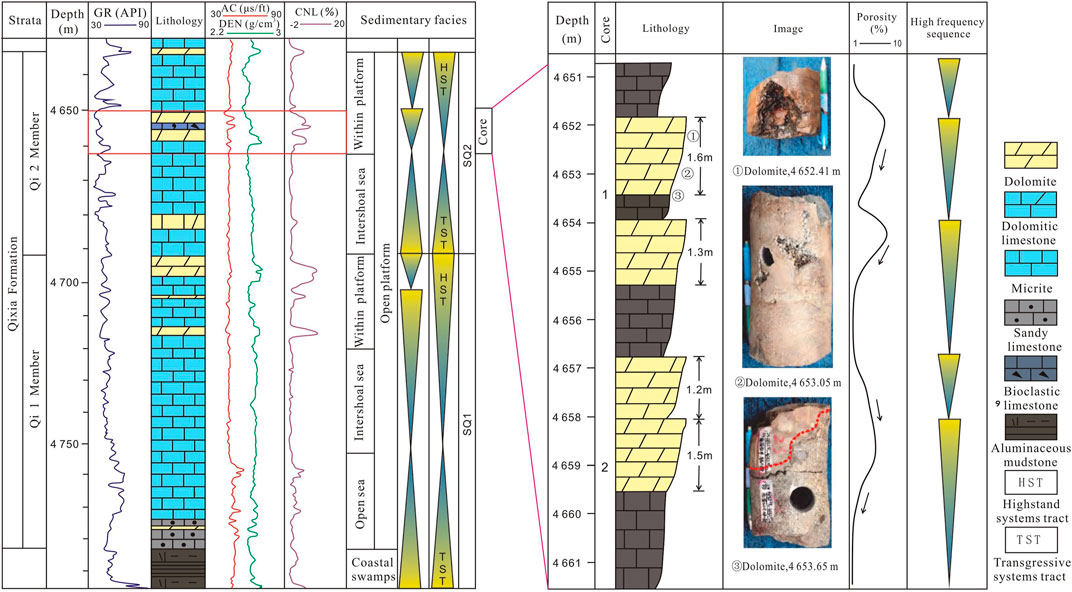
FIGURE 9. Comprehensive lithologic histogram of ixia Formation in Well Moxi 42 (modified after Duan et al., 2021).
5.2 Controlling factors of dolomite reservoir development
(1) Influence of granular shaol on reservoir development
The Permian Qixia Formation in the Sichuan Basin is mainly developed in platform margin, open platform and sag conditions. The most dominant microfacies assemblages of the Permian Qixia Formation in the central Sichuan area are the sedimentary sequences of interbeded interbeach-sea and intra-platform shoal in the open platform. In addition, it is longitudinally reflected as a rock assemblage type consisting of micritic rocks gradually transitioning upward to granular rocks (Figure 2). The granular shoal within the platform is mainly distributed in the Longnusi, Moxi and Gaoshiti areas, and its lithology mainly includes granular limestone, residual granular dolomite, dolomitic limestone and callitic dolomite. The low energy non-granular rocks have high original porosity in the sedimentary stage. However, under the influence of compaction and cementation in the early stage of shallow burial, the original pores are difficult to be preserved due to rapid compaction. Therefore, it is difficult for karst water to enter the reservoir in the diagenetic stage. Granular rocks represent strong water energy. After winnowing, the proportion of fine sediments is very low, and the contacts between particles are often point-line type. Therefore, the original pores are well preserved in the shallow burial stage. The pore development layer is a high permeability layer that allows karst water to pass through, which can promote the full water-rock interactions of karst water along the intergranular pores. Furthermore, the pore-cave or fracture-cave type reservoirs with good permeability are formed.
The study shows that the granular shoals are controlled by the sedimentary paleogeomorphology. Granular shoal are generally developed in the high parts of paleogeomorphology where the energy of the sedimentary water is high. The thickness of the shoal facies in the high parts is larger than that in the slope areas. Granular shoals are not only the material base of reservoir development, but also provide an important carrier of primary reservoir space. Bioclastic particles themselves contain coelomic pores, and intergranular pores are formed by particle accumulation. These primary pores are an important part of the effective reservoir space, and also promote the development of dissolution pores in the quasi-syngenesis.
(2) Effect of sequence interface on longitudinal distribution of reservoirs
The sedimentary cycles of the Permian Qixia Formation in the central Sichuan Basin are very clear (Figure 9). In the highstand systems tract of each cycle, high-energy deposits such as sparry clastic limestones and dolomites are developed. During the period of sea level decline in the highstand systems tract, the granular shoals developed in the high parts of the paleogeomorphology are easily exposed. At this time, some soluble minerals such as aragonite and high-magnesium calcite are dissolved by atmospheric fresh water, and pore layers and dissolution pores are formed along the bedding. At the top of the sequence interface, the dissolution pores are large, and at the bottom, there are almost no dissolution pores in the bioclastic micritic limestones. Then, a typical high-frequency cycle is formed (Figure 9). It should be noted that not every high frequency cycle will have dolomite development at the top, but the dolomite is all developed at the top of the high frequency cycle. This is well confirmed by the δ18O analysis data, which shows that dolomite (mean −6.52%) is more negative than limestone (mean −6.22%). This is because the dolomite of the Qixia Formation in the study area is usually developed at the end of the high frequency cycle, that is, the top of the high frequency cycle. At the same time, the decline of sea level inevitably leads to the gradually restricted water body in the high parts of the ancient landforms. Due to the gradual enrichment of Mg2+ in seawater by evaporation, the Mg2+-rich fluids enter the granular shoal limestones along the pre-existing dissolution pores, and then lead to the percolation and reflux dolomitization of the granular shoal limestones. This is also the reason why dissolution pores of the Qixia Formation mainly exist in dolomites.
(3) Effect of quasi-syngenetic dissolution on reservoir development
Quasi-syngenetic dissolution is one of the key diagenesis processes for the formation of high quality carbonate reservoirs. Granular shoals are exposed to atmospheric freshwater diagenetic environments under high frequency sea-level changes. At this time, the fluids in the pore of rock are mainly atmospheric fresh water, and the dissolution is significant at this stage. Unstable minerals are prone to selective dissolution of fabrics, which promotes the formation of secondary dissolution pores. The quasi-syngenetic dissolution not only promotes the development of early secondary pores, but also provides a good percolation channel for later diagenetic fluids.
The reservoirs formed by quasi-syngenetic dissolution have strong longitudinal differences. Due to the frequent rise and fall of sea level, the time of quasi-syngenetic dissolution is very limited, and the karstification of each stage of granular shoal can only reach a certain depth. Under the surface of dissolution, the dissolution of atmospheric fresh water is strong, and a large number of dissolution pores and caves are formed. However, for the lower granular shoal far from the dissolution surface, the dissolution pores are less developed due to the weak dissolution. Dissolved pores are the main pore type. Furthermore, there is a positive correlation between the sedimentary cycle of the granular shoals and the development degree of pores and the physical properties.
Through the observations of the cores of Well Moxi 42, it is found that the pores are generally developed in the middle and upper cycle of the granular shoals. The changes of core porosity and permeability have obvious characteristics of multiple sedimentary cycles (Figure 9). The development of dissolution in dolomite reservoir is closely related to the change of high frequency sea level, that is, it shows the characteristics of quasi-syngenetic dissolution. The main reasons are: 1) From the point of view of the cores, the quasi-syngenetic dissolution is manifested as the formation of dissolution pores distributed along the beddings, and most of the pores are developed in the upper cycle of the shoal; 2) From thin section observations, the quasi-syngenetic dissolution is manifested as the expansion of the primary pores such as intergranular and biocoelomic pores. Dissolution pores of different grades are well developed (Figures 3F,4B).
5.3 Distribution law of dolomite reservoirs
According to previous studies, the dolomites of the Permian Qixia Formation in the Sichuan Basin are characterized by thin single layer thickness and strong lateral heterogeneity (Tian et al., 2015). However, in this study, dolomites with thickness of several meters to 10 m were developed in the Permian Qixia Formation in central Sichuan Basin. For example, the thickness of dolomites in the areas where Wells Moxi 42, Moxi 10, Moxi 11, and Moxi 21 are located is all greater than 10 m. According to the well-connecting profile in Figure 10, dolomites are developed in the HST of SQ1 in Wells Gaoshi 18 and Gaoshi GS16. The dolomites are generally located in the middle part of the Qixia Formation. In addition, dolomites are developed in the HST of SQ2 in Wells Moxi 31X1 and Moxi 42. The dolomites are generally located 10–20 m away from the top of the Qixia Formation. The dolomite reservoirs of the two adjacent wells have similar development positions. This indicates that the dolomites of the Permian Qixia Formation in the central Sichuan Basin have good transverse continuity in a certain area.
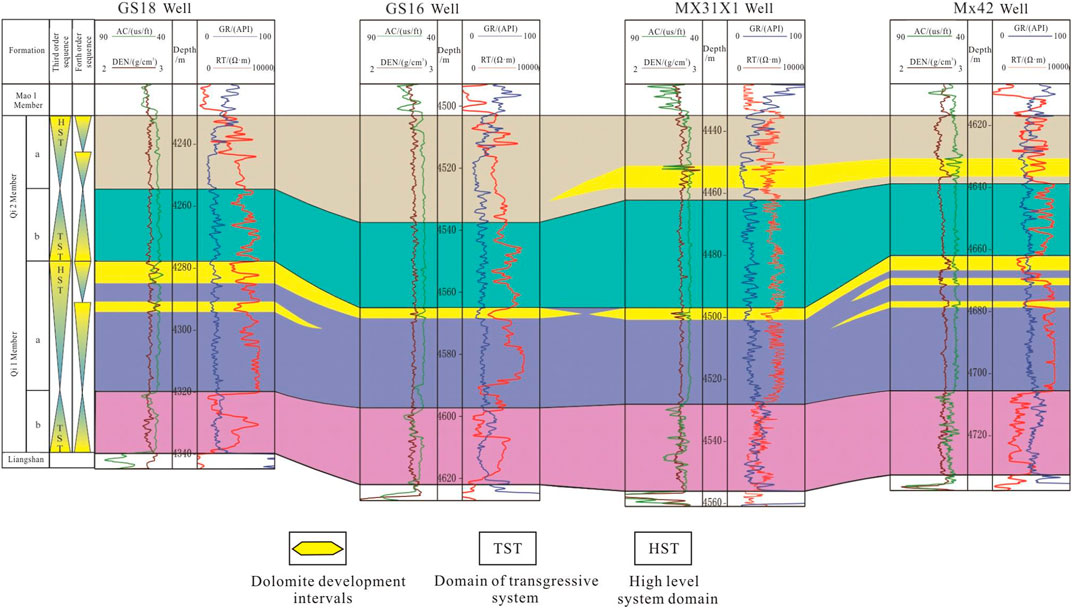
FIGURE 10. Interwell correlation profile of dolomite reservoirs of Permian Qixia Formation in central Sichuan Basin.
According to the above research, the development of dolomite reservoirs is affected by many factors. The paleogeomorphic highlands in the paleo-sedimentary period are the dominant topographic units for the development of grain shoals. During the period of sea level decline in the high level domain, the grain shoals in the high position are most prone to be exposed and then dissolved to form early pores. These pores provide channels for early dolomitization, and early dolomitization is conducive to the preservation of early pores. On the other hand, the water energy in the high parts of paleogeomorphology during the deposition period was high, so the deposition thickness was significantly higher than that in the surrounding areas. Therefore, the areas with large sedimentary thickness of the Qixia Formation is the favorable areas for the development of dolomite reservoirs. The planar distribution of dolomite reservoirs is shown in Figure 11.
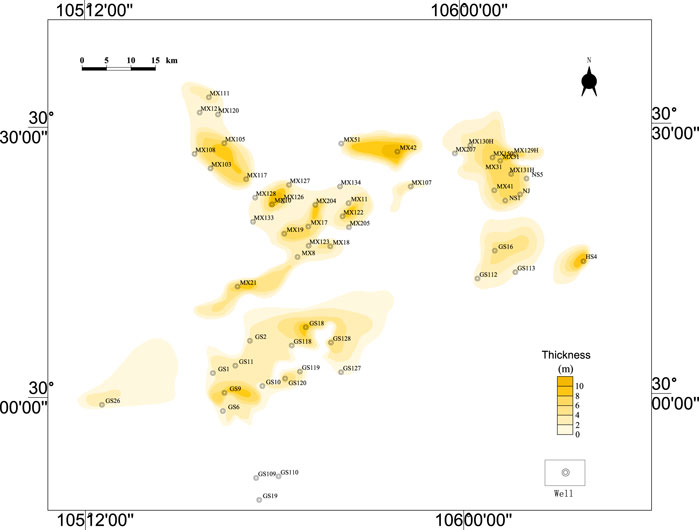
FIGURE 11. Thickness distribution of dolomite reservoirs of Permian Qixia Formation in central Sichuan Basin.
Firstly, the macro distribution range of dolomite of the Qixia Formation is predicted by the palaeogeomorphology restoration. In addition, the planar distribution of dolomite reservoir can be predicted according to the seismic response of dolomite reservoirs. Finally, the distribution of dolomite reservoirs is predicted by the geological and seismic results. The dolomite shoals in the study area are distributed as clumps in the plane, and they cover a total area of 1,940 km2. The thickness of dolomite reservoirs exposed by drillings is distributed in 6 m–12 m, and the thickness of dolomite reservoirs revealed by the Gaoshi 128 well is 16.7 m. Moreover, several wells, such as Wells Moxi 31X1, Moxi 42, Gaoshi 18, Heshen two and Heshen 4, have obtained high production gasflows. It shows that the dolomites of the Permian Qixia Formation in central Sichuan Basin has great potential for oil and gas exploration and development.
6 Conclusion
(1) The dolomites developed in the Permian Qixia Formation in the central Sichuan Basin have the characteristics of small single-layer thickness and multi-layer development, and they are interbeded with the limestones. The reservoir types are mainly fine crystal dolomite and fine medium crystal dolomite, and the reservoir spaces are mainly intercrystalline pores and caves. Moreover, the reservoir physical properties are characterized by medium porosity and medium to high permeability.
(2) Quasi-syngenetic dolomitization is the main origin of dolomite in the target layer, and the dolomite was slightly modified by hydrothermal solution at the end of the Maokou Formation period. The development of dolomite reservoirs in the Qixia Formation in the study area is affected by palaeogeomorphology, sedimentation and diagenesis.
(3) The granular shoal facies developed in the high parts of paleogeomorphology provides the material basis for the formation of dolomite reservoirs. The high frequency sequence interface controls the development of dolomite reservoirs in highstand systems tract. In addition, the quasi-syngenetic dissolution promots the development of the early secondary pores and provids an effective channel for the migration of diagenetic fluids in the later stage.
(4) In the direction of orthogonal horizontal deposition, the dolomites have the characteristics of thin monolayer thickness, multiple sequences and are interbedded with limestone. The dolomite shoals in the study area are distributed as clumps in the plane, which has great potential for hydrocarbon exploration.
Data availability statement
The original contributions presented in the study are included in the article/Supplementary Material, further inquiries can be directed to the corresponding author.
Author contributions
KT is responsible for the idea of this paper and QW, JC, JY, YQ, and YZ are responsible for the experiments.
Conflict of interest
Authors KT, QW, JC, JY, YQ, and YZ are employed by the Research Institute of Petroleum Exploration and Development Northwest Branch.
Publisher’s note
All claims expressed in this article are solely those of the authors and do not necessarily represent those of their affiliated organizations, or those of the publisher, the editors and the reviewers. Any product that may be evaluated in this article, or claim that may be made by its manufacturer, is not guaranteed or endorsed by the publisher.
References
Bau, M., and Dulski, P. (1996). Distribution of yttrium and rare-Earth elements in the penge and kuruman iron-formations, transvaal supergroup, South Africa. Precambrian Res. 79 (1/2), 37–55. doi:10.1016/0301-9268(95)00087-9
Briais, A., Patriat, P., and Tapponnier, P. (1993). Updated interpretation of magnetic anomalies and seafloor spreading stages in the South China Sea: Implications for the Tertiary tectonics of Southeast Asia. J. Geophys. Res. Solid Earth 98 (B4), 6299–6328. doi:10.1029/92JB02280
Budd, D. A. (1997). Cenozoic dolomites of carbonate islands: Their attributes and origin. Earth-Science Rev. 42, 1–47. doi:10.1016/S0012-8252(96)00051-7
Burke, W. H., Denison, R. E., Hetherington, E. A., Koepnick, R. B., Nelson, H. F., and Otto, J. B. (1982). Variation of seawater 87Sr/86Sr throughout Phanerozoic time. Geology 10 (10), 516–519. doi:10.1130/0091-7613(1982)10<516:vosstp>2.0.co;2
Chacko, T., and Deines, P. (2008). Theoretical calculation of oxygen isotope fractionation factors in carbonate systems. Geochimica Cosmochimica Acta 72 (15), 3642–3660. doi:10.1016/j.gca.2008.06.001
Chen, X., Zhao, W., and Zhang, L. (2012). Discovery and exploration significance of the Middle Permian tectonic hydrothermal dolomite in the central Sichuan Basin. Acta Pet. Sin. 33 (4), 562–569. doi:10.3969/j.issn.1672-9854.2021.04.007
Cheng, Z., Yong, S., Yiren, F., Peiqiang, Y., Xinmin, G., Fei, W., et al. (2022). Application and prospect of low-field nuclear magnetic resonance technology in accurate characterization of coal pore structure. J. J. China Coal Soc. 47 (02), 828–848. doi:10.13225/j.cnki.jccs.xr21.1766
Crozaz, G., Floss, C., and Wadhwa, M. (2003). Chemical alteration and REE mobilization in meteorites from hot and cold deserts. Geochimica Cosmochimica Acta 67 (24), 4727–4741. doi:10.1016/j.gca.2003.08.008
Davies, G. R., and Smith, L. B. (2006). Structurally controlled hydrothermal dolomite reservoir facies: An overview. AAPG Bull. 90 (11), 1641–1690. doi:10.1306/05220605164
Duan, J., Zheng, J., and Shen, A. (2021). Characteristics and Genesis of dolomite reservoir of lower permian Qixia Formation in central Sichuan Basin. Mar. oil gas Geol. 26 (4), 345–356. doi:10.3969/j.issn.1672-9854.2021.04.007
Gao, C., Meng, S., Zhang, J., Wang, J., and Sun, Y. (2023). Effects of cementation on physical properties of clastic rock-originated weathering crust reservoirs in the Kexia region, Junggar Basin, NW China. Energy Geosci. 4 (1), 74–82. doi:10.1016/j.engeos.2022.08.006
Geske, A., GoldsteinMavromatis, R. H, V., Richter, D., Buhl, D., Kluge, T., et al. (2015). The magnesium isotope (δ26Mg) signature of dolomites. Geochimica Cosmochimica Acta 149, 131–151. doi:10.1016/j.gca.2014.11.003
Haas, J., Hips, K., Budai, T., Gyori, O., Lukoczki, G., Kele, S., et al. (2017). Processes and controlling factors of polygenetic dolomite Formation in the transdanubian range, Hungary: A synopsis. Int. J. Earth Sci. 106 (3), 991–1021. doi:10.1007/s00531-016-1347-7
Hong, H., Su-ping, P., and Long-yi, S. (2004). Trace elements and sedimentary settings of Cambrian-Ordovician carbonates in Bachu area, Tarim Basin. Xinjiang Pet. Geol. 25 (6), 631.
Hu, X. M., and Wang, C. S. (1990). Several major geological events and global climate change since 100 Ma. Escploration Nat. 18 (67), 53–58. doi:10.1016/0375-6742(81)90109-6
Huang, C. G., Huang, S. J., and Wu, S. J. (2006). Evolution and main controlling factors of strontium isotopic composition in seawater from 100 Ma. J. Earth Sci. Environ. 28 (2), 19–25. doi:10.3969/j.issn.1672-6561.2006.02.004
Huang, S., Shi, H., and Zhang, M. (2001). Strontium isotope evolution and global sea level change of Carboniferous-Permian Marine carbonates in the Upper Yangtze Basin. Acta Sedimentol. Sin. 19 (4), 481–487.
Jiang, Y., Gu, Y., and Li, K. (2018). Types and Genesis of reservoir and permeability space of Middle Permian hydrothermal dolomite in the central Sichuan Basin. Nat. Gas. Ind. 38 (2), 16–24. doi:10.3787/j.issn.1000-0976.2018.02.003
Li, H., and Liu, Y. (2013). Dolomite problem” and research of ancient lacustrine dolostones. Acta Sedimentol. Sin. 3 (2), 302–315. doi:10.14027/j.cnki.cjxb.2013.02.017
Ma, L., Song, M., Wang, Y., Wang, Y., and Liu, H. (2023). Exploration progress of the paleogene in jiyang depression, Bohai Bay Basin. Energy Geosci. 4 (1), 42–50. doi:10.1016/j.engeos.2022.07.004
Machel, H. G. (2004). Concepts and models of dolomitization: A critical reappraisal. Geol. Soc. Lond. Spec. Publ. 235 (1), 7–63. doi:10.1144/gsl.sp.2004.235.01.02
Mazumdar, C., Alleno, E., Sologub, O., Salamakha, P., Noel, H., Potel, M., et al. (2003). Investigations of the structural, magnetic and Ce-valence properties of quaternary CeM2B2C compounds (M: Co, Ni Rh, Pd Ir and Pt). ChemInform 34 (11), 18–25. doi:10.1016/S0925-8388(01)01979-X
Mazzullo, S. J. (2000). Organogenic dolomitization in peritidal to deep-sea sediments. J. Sediment. Res. 70 (1), 10–23. doi:10.1306/2dc408f9-0e47-11d7-8643000102c1865d
Meyer, E. E., Quicksall, A. N., Landis, J. D., Link, P. K., and Bostick, B. C. (2013). Trace and rare Earth elemental investigation of a sturtian cap car⁃bonate, pocatello, Idaho: Evidence for ocean redox conditions before and during carbonate deposition. Precambrian Res. 192 (1), 89–106. doi:10.1016/j.precamres.2011.09.015
Morozov, V. P., Jin, Z., Liang, X., Korolev, E. A., Liu, Q., Kolchugin, A. N., et al. (2021). Comparison of source rocks from the lower silurian longmaxi Formation in the yangzi platform and the upper devonian semiluksk Formation in East European platform. Energy Geosci. 2 (1), 63–72. doi:10.1016/j.engeos.2020.10.001
Pajdak, A., Godyn, K., Kudasik, M., and Murzyn, T. (2017). The use of selected research methods to describe the pore space of dolomite from copper ore mine, Poland. Environ. Earth Sci. 76 (10), 389–416. doi:10.1007/s12665-017-6724-4
Richardson, M., Abraham-A, F., and Anthony, I. (2022). Physical properties of sandstone reservoirs: Implication for fluid mobility. Energy Geosci. 3 (4), 349–359. doi:10.1016/j.engeos.2022.06.001
Tan, K., Yao, J., Chen, J., Tang, D., Qin, Y., and Wu, Q. (2022). Controlling effect of source-reservoir assemblage on natural gas accumulation: A case study of the upper triassic xujiahe Formation in the Sichuan Basin. Front. Earth Sci. 10, 1–15. doi:10.3389/feart.2022.1028439
Tian, Y., Liu, S., and Zhao, Y. (2015). Formation mechanism of high quality reservoirs of lower cambrian longwangmiao Formation in central Sichuan Basin. J. Guilin Univ. Technol. 35 (2), 217–226. CNKI:SUN:GLGX.0.2015-02-001.
Vasconcelos, C., McKenzie, J. A., Bernasconi, S., Grujic, D., and Tiens, A. J. (1995). Microbial mediation as a possible mechanism for natural dolomite formation at low temperatures. Nature 377 (6546), 220–222. doi:10.1038/377220a0
Veizer, A., Azmy, K., Bruckschen, P., Buhl, D., Bruhn, F., et al. (1999). 87Sr/86Sr, δ13C and δ18O evolution of Phanerozoic seawater. Chem. Geol. 161 (1/3), 59–88. doi:10.1016/S0009-2541(99)00081-9
Xie, R., Luo, Z., Zhang, M., Wang, Y., Chen, J., and Zhu, M. (2022). Factors controlling tight oil and gas reservoir development in the Jurassic siliciclastic-carbonate rocks in Sichuan Basin, China. Energy Geosci. 3 (4), 453–464. doi:10.1016/j.engeos.2021.08.001
Xiong, L., Yao, G., Ni, C., Xiong, S., Shen, A., Zhou, G., et al. (2017). Characteristics, controlling factors and evolution of the middle devonian guanwushan formation reservoirs in longmenshan area, northwestern sichuan, China. Nat. Gas. Geosci. 28 (7), 1031–1042. doi:10.11764/j.issn.1672-1926.2017.06.010
Keywords: sichuan basin, qixia formation, dolomite reservoir, geochemical characteristics, origin of dolomite, exploration potential
Citation: Tan K, Wu Q, Chen J, Yao J, Qin Y and Zhang Y (2023) Development characteristics and controlling factors of dolomite reservoirs of permian Qixi a Formation in central Sichuan Basin. Front. Earth Sci. 10:1067316. doi: 10.3389/feart.2022.1067316
Received: 11 October 2022; Accepted: 19 December 2022;
Published: 11 April 2023.
Edited by:
Shuai Yin, Xi’an Shiyou University, ChinaReviewed by:
Xiangliang Qiu, Xi’an Shiyou University, ChinaFuhua Shang, Inner Mongolia University of Technology, China
Copyright © 2023 Tan, Wu, Chen, Yao, Qin and Zhang. This is an open-access article distributed under the terms of the Creative Commons Attribution License (CC BY). The use, distribution or reproduction in other forums is permitted, provided the original author(s) and the copyright owner(s) are credited and that the original publication in this journal is cited, in accordance with accepted academic practice. No use, distribution or reproduction is permitted which does not comply with these terms.
*Correspondence: Kaijun Tan, tankaijun20@126.com
 Kaijun Tan
Kaijun Tan Qingpeng Wu
Qingpeng Wu  Yang Qin
Yang Qin